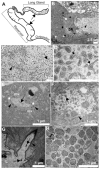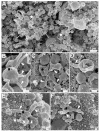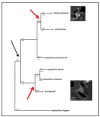VLPs of Leptopilina boulardi share biogenesis and overall stellate morphology with VLPs of the heterotoma clade
- PMID: 21704090
- PMCID: PMC3905611
- DOI: 10.1016/j.virusres.2011.06.005
VLPs of Leptopilina boulardi share biogenesis and overall stellate morphology with VLPs of the heterotoma clade
Abstract
Viruses and virus-like particles (VLPs) of insect parasitoids modify host-parasite interactions. The Drosophila wasp, Leptopilina heterotoma, produce 300 nm spiked VLPs that bind to the host's blood cells via surface projections. L. heterotoma is a generalist wasp that attacks over a dozen Drosophila species. Oviposition introduces VLPs into the hemolymph of Drosophila larvae. VLPs lyse hemocytes and obliterate immune signaling in infected larval hosts. L. boulardi, a member of a distinct Leptopilina clade, is a specialist, whose host range is limited to the melanogaster group. As a step toward understanding a potential relationship between venom contents and host range in these wasps, we used electron microscopy to characterize VLPs from the virulent L. boulardi-17 (Lb-17) strain. While the Lb-17 VLPs can neither lyse blood cells nor suppress host defense, their biogenesis is surprisingly similar to that of L. heterotoma. Like L. heterotoma VLPs, L. boulardi VLPs are stellate; but they have fewer spikes, each spike being significantly longer than the spikes in L. heterotoma VLPs. The Lb-17 VLPs possess a dimple, making them clearly distinct from L. heterotoma VLPs. We discuss the significance of these cross-clade differences in VLP morphologies in relation to their biological activities and the host range of the wasp.
Copyright © 2011 Elsevier B.V. All rights reserved.
Conflict of interest statement
The authors declare no conflict of interest.
Figures



Similar articles
-
An introduction to parasitic wasps of Drosophila and the antiparasite immune response.J Vis Exp. 2012 May 7;(63):e3347. doi: 10.3791/3347. J Vis Exp. 2012. PMID: 22588641 Free PMC article.
-
Identification and immuno-electron microscopy localization of p40, a protein component of immunosuppressive virus-like particles from Leptopilina heterotoma, a virulent parasitoid wasp of Drosophila.J Gen Virol. 2006 Feb;87(Pt 2):461-470. doi: 10.1099/vir.0.81474-0. J Gen Virol. 2006. PMID: 16432035 Free PMC article.
-
Biogenesis, structure, and immune-suppressive effects of virus-like particles of a Drosophila parasitoid, Leptopilina victoriae.J Insect Physiol. 2005 Feb;51(2):181-95. doi: 10.1016/j.jinsphys.2004.11.002. J Insect Physiol. 2005. PMID: 15749103
-
Virulence factors and strategies of Leptopilina spp.: selective responses in Drosophila hosts.Adv Parasitol. 2009;70:123-45. doi: 10.1016/S0065-308X(09)70005-3. Adv Parasitol. 2009. PMID: 19773069 Free PMC article. Review.
-
Variation of Leptopilina boulardi success in Drosophila hosts: what is inside the black box?Adv Parasitol. 2009;70:147-88. doi: 10.1016/S0065-308X(09)70006-5. Adv Parasitol. 2009. PMID: 19773070 Review.
Cited by
-
Parasitoid wasp virulence: A window into fly immunity.Fly (Austin). 2013 Oct-Dec;7(4):242-8. doi: 10.4161/fly.26484. Epub 2013 Oct 2. Fly (Austin). 2013. PMID: 24088661 Free PMC article.
-
Novel Organelles with Elements of Bacterial and Eukaryotic Secretion Systems Weaponize Parasites of Drosophila.Curr Biol. 2017 Sep 25;27(18):2869-2877.e6. doi: 10.1016/j.cub.2017.08.019. Epub 2017 Sep 7. Curr Biol. 2017. PMID: 28889977 Free PMC article.
-
Parasitoid wasp venom vesicles (venosomes) enter Drosophila melanogaster lamellocytes through a flotillin/lipid raft-dependent endocytic pathway.Virulence. 2020 Dec;11(1):1512-1521. doi: 10.1080/21505594.2020.1838116. Virulence. 2020. PMID: 33135553 Free PMC article.
-
An introduction to parasitic wasps of Drosophila and the antiparasite immune response.J Vis Exp. 2012 May 7;(63):e3347. doi: 10.3791/3347. J Vis Exp. 2012. PMID: 22588641 Free PMC article.
-
Venom vesicles from the parasitoid Ganaspis hookeri facilitate venom protein entry into host immune cells.bioRxiv [Preprint]. 2025 May 14:2025.05.08.652939. doi: 10.1101/2025.05.08.652939. bioRxiv. 2025. PMID: 40463271 Free PMC article. Preprint.
References
-
- Allemand R, Lemaitre C, Frey F, Bouletreau M, Vavre F, Nordlander G, van Alphen J, Carton Y. Phylogeny of six African Leptopilina species (Hymenoptera : Cynipoidea, Figitidae), parasitoids of Drosophila, with description of three new species. Ann Soc Entomol Fr. 2002;38(4):319–332.
-
- Bezier A, Annaheim M, Herbiniere J, Wetterwald C, Gyapay G, Bernard-Samain S, Wincker P, Roditi I, Heller M, Belghazi M, Pfister-Wilhem R, Periquet G, Dupuy C, Huguet E, Volkoff AN, Lanzrein B, Drezen JM. Polydnaviruses of braconid wasps derive from an ancestral nudivirus. Science. 2009a;323(5916):926–930. - PubMed
-
- Bezier A, Herbiniere J, Lanzrein B, Drezen JM. Polydnavirus hidden face: the genes producing virus particles of parasitic wasps. J Invertebr Pathol. 2009b;101(3):194–203. - PubMed
-
- Chiu H, Govind S. Natural infection of D. melanogaster by virulent parasitic wasps induces apoptotic depletion of hematopoietic precursors. Cell Death Differ. 2002;9(12):1379–1381. - PubMed
Publication types
MeSH terms
Substances
Grants and funding
LinkOut - more resources
Full Text Sources
Research Materials

